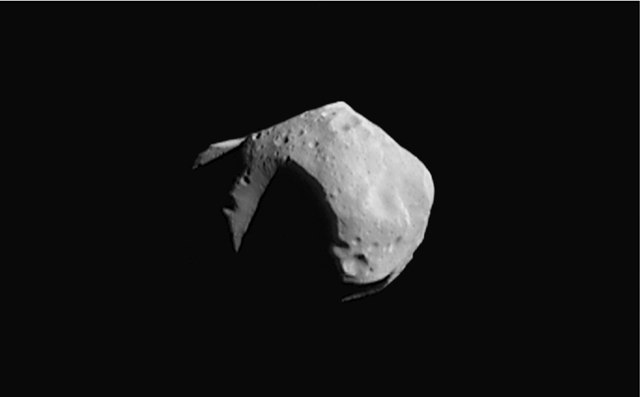 Eiffel Tower-sized asteroid is set to fly past the Earth. Credit: NASA / Wikimedia Commons / Public Domain
Eiffel Tower-sized asteroid is set to fly past the Earth. Credit: NASA / Wikimedia Commons / Public DomainA super-sized 1,312 feet long asteroid is expected to fly past the Earth on April 26th. NASA’s Center for Near-Earth Object Studies (CNEOS) says that the asteroid, named 2006 HV5, will travel at around 38,922 mph. This is much faster than a bullet, about 22 times faster!
The asteroid is also about 1,300 feet across. To give you an idea, the Eiffel Tower is a little shorter, at under 1,100 feet. 2006 HV5 will fly by the Earth at a distance of 6.3 lunar distances. That means it will be 6.3 times farther away from us than the moon.
Even though it might seem very far away, it’s actually very close in space terms – about 1.5 million miles away. In comparison, our nearest neighbor planet, Venus, is about 38 million miles away from us at its closest point.
What Are Asteroids?
Asteroids are fragments of rock that were left over from the early stages of the solar system’s creation, which occurred billions of years ago. The asteroid belt is where the vast majority of asteroids are located.
Asteroids have a variety of shapes and sizes, ranging from tiny ones measuring only 30 feet to the largest ones being hundreds of miles across. Among the largest asteroids in our solar system are Ceres, with a diameter of 587 miles, and Vesta, measuring around 329 miles across.
A variety of factors cause asteroids to break out of their belt and make their way toward the Earth and other planets.
According to a senior planetary astronomer at the SETI Institute, Franck Marchis, “We believe they formed in the asteroid belt and got ejected by impact (in this case the asteroid is a fragment of the large impacted asteroid), or their orbits were destabilized due to the presence of Jupiter resonances in the belt.”
Other Astronomical Bodies
2006 HV5 is only one of the more than 31,000 near-Earth objects, or NEOs, that have been detected by scientists up to this point. NEOs are described as astronomical bodies that pass within 30 million miles of Earth’s orbit.
Among them, there is a subcategory of “potentially hazardous objects,” defined as those coming within 4.6 million miles of Earth’s orbit and measuring more than 460 feet in diameter. NASA has identified around 2,300 potentially hazardous objects until now.
Asteroids that come close to the Earth are often spotted only a few days before they pass by. However, this is not because we miss larger ones, but rather because we have become better at identifying even smaller objects.
An astronomer working with the Virtual Telescope Project by the name of Gianluca Masi claims that “The increase we see in the detection rate of small asteroids is mainly due to our improving capabilities to spot small objects. Hopefully, this rate will increase more and more. It is a good thing, it says we are better and better at monitoring the sky and keeping our planet safe.”
Fortunately, there is very little chance that 2006 HV5 will collide with the Earth. Instead, it will fly past us and continue on its journey through the rest of the solar system.

 1 year ago
81
1 year ago
81











 English (US)
English (US)